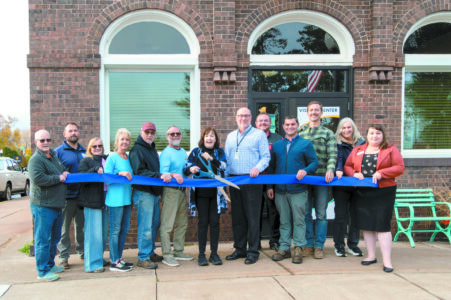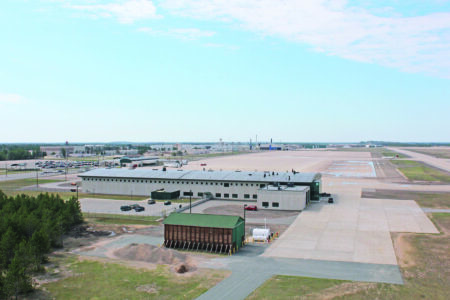New interest in domestic mining comes with call for sustainability in the market

Protect the Porkies founder Tom Grotewohl speaks to protestors on the lawn of the Michigan Capitol on Sept. 10. (Photo courtesy of Joe Lorenz)
MARQUETTE – Electrification and tariffs mean rural Midwest communities can cash in on their mineral resources.
But how can these ventures balance local benefit with the ecological cost?
The market for domestic critical metals has gained momentum due to the push for electrification, partly to power data centers. Tariffs make the costs of imported critical minerals volatile.
These limiting factors have also resulted in innovations in second-hand sourcing, making recycling of critical minerals financially viable.
The Upper Peninsula’s history of mining for iron, copper and nickel have developers eyeing the region for future mining development.

A group of counter-protestors in dress suits who support the Copperwood mine are confronted by protestors against the mine. (Photo courtesy of Joe Lorenz)
“For too long, the United States has relied on foreign actors to supply and process the critical materials that are essential to modern life and our national security,” said U.S. Secretary of Energy Chris Wright in an August press release.
“I’m a firm believer in bringing things home to the United States so that we’re not dependent on other countries,” said U.S. Sen. Elissa Slotkin, D-Michigan, told Houghton’s Daily Mining Gazette, “and we know the Western UP knows how to mine copper safely and effectively.”
This development could help domestic manufacturers gain access to critical minerals for batteries and electronics without the uncertainty that the Trump administration’s tariffs bring to importers and supply chains.
“The reality is, in some cases, mining is the only game in town,” said Gary Campbell, a professor of natural resource economics at Michigan Technological University.
He explained that without the revenue mines generate, local economies suffer and municipalities struggle to fill gaps in their budgets. A new mine is often promoted as a path to economic growth, but local communities might need more than extraction alone, according to Campbell.
The answer, he said, is in how well the mining company manages its relationship with the community once the mine shuts down.
“The better you leave them, the more open the next community will be, and so (mining companies) think it’s in their own interest to try to help out the community and smooth over the transition,” said Campbell.
He referred to the reclaimed Flambeau mine in Ladysmith, Wisconsin – a site that now features a 5-mile nature trail with native species – as a case study in how a mine can leave a positive impact on a community while balancing the environmental cost of excavating ore.
The Eagle Mine in Marquette County is at a similar crossroads of sourcing critical minerals for the U.S. economy while making a lasting, positive environmental impact in the local community.
The call for sustainable mineral sourcing and increased demand for domestic production has paved the way for a partnership between the Eagle Mine and companies developing innovations in the mining sector.
Revex Technologies, a company founded in 2023 and awarded a $145 million grant from the U.S. Department of Energy, is working with Eagle Mine to develop a processing facility in northern Michigan to reprocess old waste rock for trace amounts of critical minerals.
The new facility would also include a system for recycling batteries and other e-waste.
A mine’s economic benefit extends to the nearby community, providing work opportunities for truckers, utility workers, restaurant staff and more. When the mine closes, many of these jobs disappear.
According to Revex, recycling offers a longer-term solution for these communities.
But a crumbling economy isn’t all these communities have to face after the conveyor belts stop and the last truck has left the city limits.
According to the U.S. Environmental Protection Agency, sulfide minerals like copper, gold and nickel pose a risk to the surrounding environment when mining waste containing trace amounts of the minerals oxidize to form sulfuric acid.
This process known as acid mine drainage can contaminate surrounding soil and waterways. The primary sources of acid mine drainage are abandoned sulfide mines and tailing pits – large open-air pits where waste rock pulled from the earth is stored.
“As soon as some sort of excavation or erosion activity happens that exposes that rock to things like water and oxygen, that production of acid starts,” said Nathan Manser, a professor of geological and natural sciences at Michigan Technological University.
“A lot of the ancient or archaic infrastructure that first came about in that industry wasn’t designed or closed down in a way that prevents that reaction from happening,” he said.
Manser explained that modern mining companies are vigilant and acid mine drainage is now rare due to improved storage techniques that reduce the minerals’ contact with oxygen and moisture.
The Copperwood project aims to source copper from a deposit that sits below a southwestern portion of the Porcupine Mountains. The mine would feature a tailing pit within 2 miles of Lake Superior’s shore and poses a risk to the lake from acid mine drainage, project critics claim.
“Anything that is important and is attached to something in the environment is fragile and endangered right now,” said David Yost, a 79-year-old protester who came to the Protect the Porkies rally in Lansing to oppose funding of the
- Protect the Porkies founder Tom Grotewohl speaks to protestors on the lawn of the Michigan Capitol on Sept. 10. (Photo courtesy of Joe Lorenz)
- A group of counter-protestors in dress suits who support the Copperwood mine are confronted by protestors against the mine. (Photo courtesy of Joe Lorenz)
The rally was intended to pressure legislators into voting against approving $50 million in state funds to help establish the mine.
State funding for the project was cut from the final budget that Gov. Gretchen Whitmer signed on Oct. 7.
EDITOR’S NOTE: Joe Lorenz writes for Great Lakes Echo.







